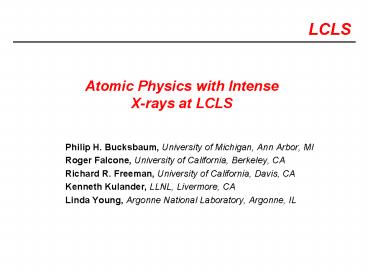Atomic Physics with Intense Xrays at LCLS PowerPoint PPT Presentation
1 / 17
Title: Atomic Physics with Intense Xrays at LCLS
1
Atomic Physics with Intense X-rays at LCLS
- Philip H. Bucksbaum, University of Michigan, Ann
Arbor, MI - Roger Falcone, University of California,
Berkeley, CA - Richard R. Freeman, University of California,
Davis, CA - Kenneth Kulander, LLNL, Livermore, CA
- Linda Young, Argonne National Laboratory,
Argonne, IL
2
Dual Motivation to Perform Atomic Physics Studies
- Fundamental Science
- The LCLS, as a high-intensity high-energy photon
source, provides a unique opportunity to study
fundamental aspects of x-rays interacting with
atoms, ions, molecules, and clusters - Foundation for all experimental planning
- The understanding of x-rayatomic physics
interactions is central to experimental designs
at the LCLS, as well as all nextgeneration x-ray
sources.
3
The LCLS will Reach Regime that are Currently
Unobtainable
Current laser-atom process at I 1014 W/cm2
amplitude of free e-
Field modulates the atomic potential at
visible laser frequency Outer e- has time to
tunnel free 2Up gt Ip where Up µ (I
l2)2 Strong interaction between free e- and
ion core is of interest
ion core
LCLS-atom process at I 1014 W/cm2
Field modulates the atomic potential at x-ray
laser frequency e- do not have time to tunnel
free Important processes are with deeply bound
core e-
4
New Fundamental Processes will be Observable
Experiment 1 Multiple ionization sufficiently
rapid to form hollow atoms
Experiment 2 Multiphoton ionization yielding
absorption below the edge
Experiment 3 Giant Coulomb explosions of clusters
5
The Experimental Setup for all these Experiments
is the Same
Charged particle detector
Tunable LCLS
X-ray detector
- Detectors
- Charge state spectrometer
- Electron energy spectrometer
- Ion recoil detector
- X-ray fluorescence detector
Atom or cluster source
6
Experiment 1 Multiple ionization forming hollow
atoms
Ionization G 1012s-1 Auger G 4x1014s-1
75 events/pulse
7
Multiple Ionization Forms Hollow Atoms
Ne Photoionization
- Neon will display the effect well
- Relatively high photoionizations
- Non-corrosive monatomic sample
- Simple, well understood spectrum
- Relatively long Auger decay rate (2.5 fs)
- Auger relaxation gt 100 x radiative fluorescence
n2
n1
8
Possible Ionization Processes for LCLS
Interacting with Ne
- Photoionization
- Ne hngt870eV ? Ne(K) e
- Auger Decay
- Ne hngt870eV ? Ne(K) e ? Ne2(LL) e
- ? Ne3 2e
- Sequential multiphoton ionization
- Ne hngt870eV ? Ne(K) e hngt993eV ?
Ne2(KK) e ? Ne3 e - ? Ne4 2e
- ? Ne5 3e
- ?
- Ne hngt870eV ? Ne(K) e hngt993eV ?
Ne3(KLL) e - Direct multiphoton ionization
- Ne 2 hngt932eV ? Ne2(KK) 2e
LCLS only
9
One Photon or Two? An Extremely Difficult
Question for Multielectron/multiphoton Systems
- The intensity of the LCLS makes numerous
processes possible/probable - For example (KL) double vacancies are possible
- Ne hngt910ev ? Ne2(KL) 2e (10)
- ? Ne3 e (9.5)
- ? Ne4 e (0.5)
- Experimentally background signals of this type
can be rejected by electron spectroscopy - Calculationally simulations of the LCLS atom
interactions and the core relaxations are
necessary
LCLS will allow the study of detailed
multiphoton atomic core processes
10
Experiment 2 Focused beam experiments
LCLS
Saturation photoionization rate equals the Auger
decay rate
Kr source
Kirkpatrick-Baez mirror pairs (demagnification
factor of 100)
detector
2x106 events/pulse
Focusing permits observation of two-photon
photoabsorption
11
2-Photon Absorption in Kr
Kr energy levels
Kr photoabsorption
n 4
1700 ev
n3
n 3
n2
n 2
n 1
hn
2hn
2 LCLS photons with hngt850eV
Schematic of Kr ionization process
12
2-Photon Absorption Detecting Events
Excitation mechanism
Kr 2hngt850eV ? Kr(L) e
Detection signatures radiation and 2x106 1.5
keV e-/pulse
Kr(L) e ? Kr(M) hn1.5keV
Kr(L) e ? Kr(MM) e(1.5keV)
radiation
particles
13
Theory of Resonant 2-Photon Processes Requires
Data Only LCLS Can Provide
- Huge enhancements associated with single photon
resonances S. A. Novikov, J. Phys. B. 33 (2000) - 2-photon rate exceeds 1-photon rate!
- Rate can be affected by coherence and enhancement
due to correlation
2-photon ionization couples to an
intermediate state 1s22s22p6
1s2s22p6np 1s2s22p6e-
14
Experiment 3 Intense X-ray beam interacting with
clusters
- LCLS
- focused and unfocused
detector
- Detectors
- Charge state spectrometer
- Electron energy spectrometer
- Ion recoil detector
- cluster source
15
Cluster Explosion Experiment with Unfocused Beam
- Xe clusters (109 atoms)
- Each atom exposed to the unfocused beam will
undergo - 1 ionization event (1031 photons/cm2/s x10-19
cm2 x10-13 s) - ? the ionization will saturate
- The dominant relaxation mechanism is Auger decay
- Therefore, each ionized atom creates 2 or more
electrons - The cluster becomes a ball of charge with 109
ions - Yields fast electrons, fast ions, and x-rays
Due to x-ray penetration the Coulomb
explosion gtgt conventional lasers
16
Cluster Explosion Experiment with Focused Beam
- Focusing the LCLS beam to 0.01 ?m
- Each atom in the cluster will be
classically-ionized nearly 104 times over - The atom will continue to ionize, as the 0.1 fs
Auger rates are 1000 times faster than the
ionization rate - Thus, each atom will ionize until it strips down
to the core level of the initial ionization
event - Understanding these processes in detail is
central to the imaging of bio-molecular samples
Lysozyme molecule irradiated by LCLS
17
Summary Dual Payoff From Atom Studies
- Fundamental Science
- LCLS is a unique opportunity to study new
fundamental multiple photon x-ray phenomena. - Foundation for all experimental planning
- Ionization and cluster dynamics are central to
experimental designs at the LCLS, as well as all
next generation x-ray sources.

